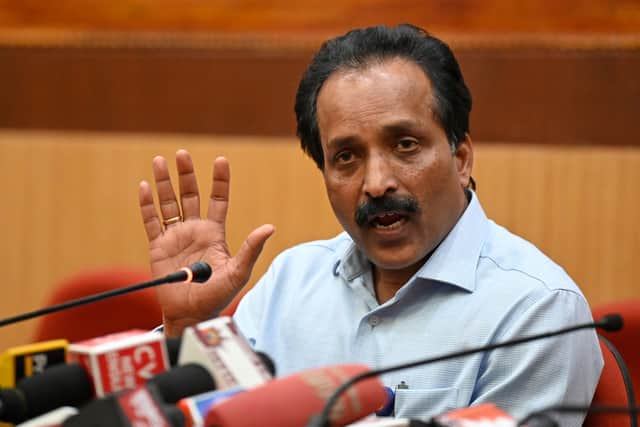Chandrayaan-3: meet the team behind India's historic Moon mission
and live on Freeview channel 276
The Indian spacecraft Chandrayaan-3 has successfully landed on the Moon at 6:04pm IST (1:34pm BST).
For Isro, the Indian space agency, this marks a momentous occasion as it makes India the fourth nation to ever soft land on the Moon and the first to land near the Moon's south pole.
Advertisement
Hide AdAdvertisement
Hide AdHundreds of people worked behind the scenes to make the landing possible. Below are five key scientists behind the mission.
Sreedhara Somanath, ISRO Chairman
Better known as S Somanath, he is the brain behind India's ambitious Moon mission and Isro's chief.
Somanath has headed Isro's other missions, including Gaganyaan and Sun-mission Aditya-L1, as per a TOI report. He was also the director of the Vikram Sarabhai Space Centre (VSSC) and the Liquid Propulsion Systems Centre — the primary centres for developing rocket technologies for Isro, before heading India's space organisation.
While announcing the news of the landing, Somanath said, "India is on the moon. The PM congratulated all of us and said that he would like to personally come down and congratulate each one of us. ISRO's next mission is Aditya L-1 mission which is getting ready at Sriharikota."


P Veeramuthuvel, Chandrayaan-3 Project Director
Advertisement
Hide AdAdvertisement
Hide AdP Veeramuthuvel is the project director of Chandrayaan-3, taking charge in 2019. Before this role. he was the deputy director at the Space Infrastructure Programme Office at Isro's main office.
“We have become the first country to go near the South Pole of the Moon,” he said after the successful landing on the lunar surface, said to loud applause from his Isro colleagues.
S Unnikrishnan Nair, Director of Vikram Sarabhai Space Centre (VSSC)
S Unnikrishnan Nair is the Director of VSSC located in Thumba, Kerala. VSSC was responsible for developing the Geosynchronous Satellite Launch Vehicle (GSLV) Mark-III, now known as Launch Vehicle Mark-III. He is known for his work in the field of launch vehicle design, Space Capsule Recovery Experiment (SRE), and Human Spaceflight Programme. Prior to his directorship of VSSC, he was the director of Human Space Flight Centre, Bengaluru.
Mohana Kumar, Mission director
S Mohana Kumar, a senior scientist from the Vikram Sarabhai Space Centre, is the mission director for Chandrayaan-3. He has worked as the director for the successful commercial launch of the One Web India 2 satellites on board the LVM3-M3 mission. "The LVM3-M4 has once again proved to be the most reliable heavy lift vehicle for Isro. Congratulations to the teamwork of the Isro family," TOI quoted Kumar as saying.
M Sankaran, Director of U R Rao Satellite Centre (URSC)
Advertisement
Hide AdAdvertisement
Hide AdIn 2021, M Sankaran assumed the role of Director at the U R Rao Satellite Centre (URSC). He leads the team responsible for creating satellites for India's needs, such as communication, navigation, remote sensing, weather forecasting, and planetary exploration. URSC is tasked with designing and constructing all of India's satellites for Isro.
Comment Guidelines
National World encourages reader discussion on our stories. User feedback, insights and back-and-forth exchanges add a rich layer of context to reporting. Please review our Community Guidelines before commenting.
